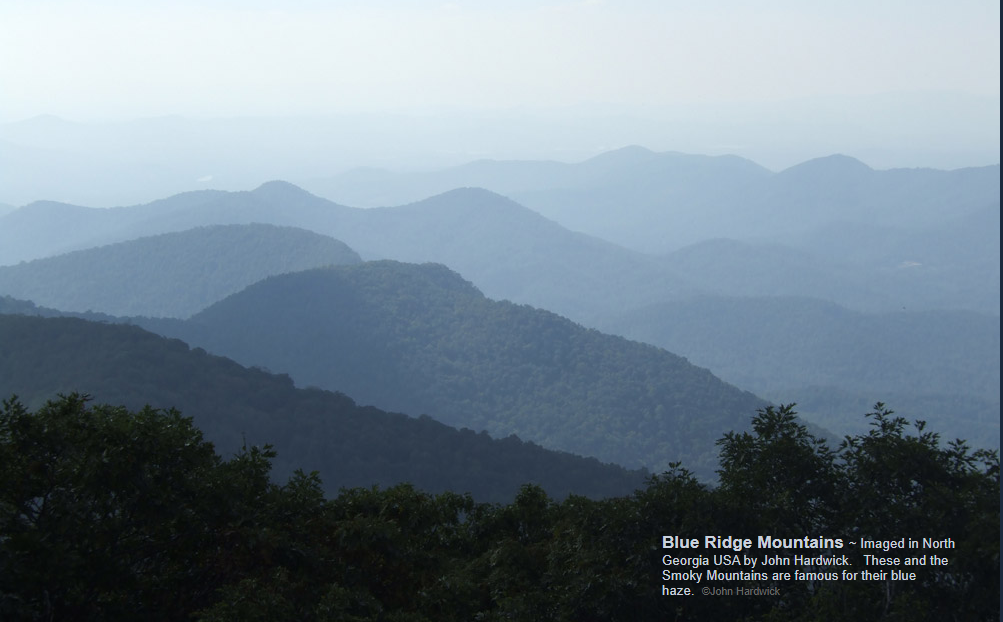OPOD - Blue Forests
Blue Forests: Unveiling the Mystery Behind the Blue Haze in the Blue Ridge Mountains
The Blue Ridge Mountains, located in North Georgia, USA, have long been renowned for their enchanting blue haze. This ethereal phenomenon, observed not only in the Blue Ridge Mountains but also in other heavily forested areas, is the result of a combination of haze and airlight. In this article, we will delve into the fascinating science behind the creation of this mesmerizing blue hue and explore the role of aerosols, trees, and sunlight in shaping this atmospheric spectacle.
The Science Behind the Blue Haze
Haze, which plays a significant role in producing the blue appearance, arises from the scattering of sunlight by small airborne particles and aerosols. When these particles are smaller than the wavelength of light, known as Rayleigh scatterers, they exhibit a stronger scattering effect on blue light compared to red light. As a result, the haze takes on a bluish hue. Conversely, larger particles contribute to the formation of a whiter haze.
The Blue Ridge Aerosol: A Forest's Contribution
One key factor in generating the Blue Ridge aerosol is the abundant presence of trees. Trees emit volatile and reactive hydrocarbons, such as α- and β-pinene, which are responsible for the distinctive scent of pine forests. While these terpenes are invisible gases, when exposed to sunlight, they undergo photochemical reactions with atmospheric ozone and sulfur acids. These reactions lead to the formation of nano-sized particles that scatter light and contribute to the blue haze. Interestingly, this process shares similarities with the creation of photochemical smog, which can have undesirable effects in urban environments.
Airlight: The Veil Over Distant Scenes
Airlight, on the other hand, is a phenomenon that occurs universally and influences the bluish appearance of mountains and distant landscapes. It is most pronounced when the sun is at its zenith. Air molecules have a tendency to scatter shorter wavelength (blue) light more readily, creating a veil-like effect over far-off objects. This scattering phenomenon, known as Rayleigh scattering, is the same mechanism responsible for the blue color of the sky.
The Beauty of Blue Forests
The captivating blue haze in the Blue Ridge Mountains and other forested regions offers a unique and enchanting visual experience. By understanding the scientific processes behind this phenomenon, we can appreciate the intricate interplay of sunlight, aerosols, and natural emissions from trees.
Exploring the Blue Ridge Mountains
If you ever find yourself in the vicinity of the Blue Ridge Mountains, take a moment to immerse yourself in the breathtaking beauty of the blue forests. Witness the mystical blue haze as it dances among the towering trees, creating an atmosphere of tranquility and wonder. As you explore the trails and scenic vistas, marvel at the ever-changing shades of blue that envelop the landscape.
Environmental Implications
While the blue haze in natural settings is a captivating sight, it is important to note that similar chemical reactions can lead to photochemical smog in urban areas. This serves as a reminder of the delicate balance between natural processes and human activities. By studying these atmospheric phenomena, scientists can gain valuable insights into the impact of pollutants on our environment and work towards finding sustainable solutions.
Conclusion
The Blue Ridge Mountains and their blue forests have captivated the imagination of countless visitors throughout the years. The interplay between sunlight, aerosols, and tree emissions creates a mystical blue haze that adds an ethereal touch to these majestic landscapes. Understanding the science behind this atmospheric phenomenon not only deepens our appreciation for nature's wonders but also highlights the importance of preserving our environment for future generations to enjoy. So, next time you find yourself gazing at a distant blue mountain range or wandering through a forest shrouded in a gentle blue haze, take a moment to reflect on the intricate processes that have shaped this captivating spectacle.

Blue Ridge Mountains ~ Imaged in North Georgia USA by John Hardwick. These and the Smoky Mountains are famous for their blue haze. ©John Hardwick
Haze and airlight produce the blues. The haze is special to the Blue Ridge Mountains and many other heavily forested areas.

Haze is the result of sunlight scattering by small airborne particles and aerosol. When the particles are smaller than the wavelength of light (Rayleigh scatterers) they scatter blue much more strongly than red and the haze appears bluish. Larger particles give a whiter haze.
What produces the Blue Ridge aerosol? Trees are copious emitters of volatile and reactive hydrocarbons such as monoterpines like α- and β-pinene. These are largely responsible for the characteristic smell of pine.
The terpenes are gaseous and invisible but in sunlight they undergo photochemical reactions with atmospheric ozone and sulphur acids to produce nano-sized particles. These scatter light to give the blue haze. It is a form of photochemical smog that in city air via a similar series of chemical reactions can be undesirable.
Airlight occurs anywhere and is responsible for mountains and distant scenes appearing progressively bluish. It is strongest when the sun is high. Air molecules preferentially scatter short wavelength (blue) light producing in effect a veil over distant objects. This is the same Rayleigh scattering that produces the blue sky.
Note: this article has been automatically converted from the old site and may not appear as intended. You can find the original article here.
Reference Atmospheric Optics
If you use any of the definitions, information, or data presented on Atmospheric Optics, please copy the link or reference below to properly credit us as the reference source. Thank you!
-
<a href="https://atoptics.co.uk/blog/opod-blue-forests/">OPOD - Blue Forests</a>
-
"OPOD - Blue Forests". Atmospheric Optics. Accessed on April 19, 2024. https://atoptics.co.uk/blog/opod-blue-forests/.
-
"OPOD - Blue Forests". Atmospheric Optics, https://atoptics.co.uk/blog/opod-blue-forests/. Accessed 19 April, 2024
-
OPOD - Blue Forests. Atmospheric Optics. Retrieved from https://atoptics.co.uk/blog/opod-blue-forests/.